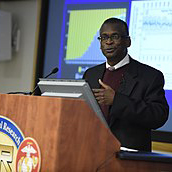By Dr. Lisa Brock (conceptual and editorial support from Dr. Regina Stevens-Truss)
Many people in the United States, in some way, participate in celebrating Black History Month. How many people, however, know the catalyst of this ritual? This February’s post is in honor of the man who founded what was first Black History Week, which then became Black History Month, Carter G. Woodson (1875-1950).
Carter G. Woodson was born in 1875 in New Canton, Virginia, to formerly enslaved African Americans, James and Eliza Riddle Woodson. As a child, like many of his time, he worked as a sharecropper, a coal miner and various other jobs to help support his large family. Because of a lack of opportunity, he entered high school late, but according to all of his teachers, he was so bright that he graduated in only two years. He then attended Berea College in Kentucky, and while there, taught at Winona, Fayette County, WV in a school established by Black coal miners for their children. (Yes, there were and still are Black coal miners). Woodson continued his education at the University of Chicago, where in 1908 he earned two bachelor’s degrees as well as a Master’s degree in European History. Woodson also studied at the Sorbonne in Paris, and in 1912 earned a Ph.D. at Harvard University in history. Woodson was the second African American to earn a Ph.D. from Harvard University; Dr. W. E. B. DuBois was the first to achieve this in 1907.
In the summer of 1915 thousands of African-Americans traveled to Chicago from around the country to celebrate the fiftieth anniversary of emancipation. This major celebration showcasing African-Americans’ progress and achievements after the end of enslavement was held at the Chicago Coliseum. According to records, at one point, an overflow crowd of six to twelve thousand waited outside for their turn to view the exhibits. This event spurred Woodson to begin the work towards honoring Black History. Inspired by the three-week celebration, before he left Chicago he decided to form an organization to promote the academic study of Black life and history. On September 9, 1915, Woodson met with other Black intellectuals at the Wabash YMCA in Chicago and formed the Association for the Study of Negro Life and History (ASNLH). One year later the organization established the Journal of Negro History.
Woodson, though, understood that if they were going to promote and popularize the history of African-Americans that they needed greater impact beyond the journal. He urged Black civic organizations to promote the journal and the achievements that researchers were uncovering. As a graduate member of the Omega Psi Phi fraternity, he urged his brothers to take up the work, and in February of 1924, they created the Negro History and Literature Week.
From the beginning, Woodson found a huge response to his call. Negro History and Literature Week appeared across the country in Black schools, churches and popular spaces. The 1920s, after all, was the decade of Marcus Garvey’s Black Pride Parades, the Harlem Renaissance, and the New Negro, a name given to the Post-War I generation because of its rising racial pride and consciousness. Urbanization and industrialization had brought over a million African Americans from the rural South into big cities of the nation, which became centers of expanding literacy and confidence. The expanding Black working and middle classes became participants in and consumers of Black literature and culture. Black history clubs sprang up and teachers demanded materials to instruct their pupils. Even some progressive whites endorsed the efforts.
It is interesting to note that Woodson’s first inspiration for the study of Black History was actually based on his experience in the Philippines. How you might ask did Woodson get to the Philipines? The US government, in the aftermath of the Spanish American War, decided to use some African-Americans in their colonial territories. Woodson, because of his accomplishments, was sent to the Archipelago in 1903 to work as an education superintendent. He quickly became concerned that the learning materials he had been given focused on European and White American history and he worried that this would have a negative effect on the confidence and sense of self of the Filipino people. After this experience he returned to the US determined to change the experiences for African-Americans. In fact, although he is the author of over a dozen books, his most well-known work is The Mis-education of the Negro . This text is still in publication today and is a grounding text for how the silences and erasures of Black History can have a negative effect on Black people.
Carter G. Woodson died in 1950 but his legacy lives on. Honored as the Father of Black History, the organization and journal that he founded continue to thrive and are known today as The Association for the Study of African-American Life and History (which still conducts an annual conference) and the Journal of African-American History. And oh yes, of course, we now celebrate Black History Month during the month of February!
Let’s celebrate Black history today and every day!
Regina Stevens-Truss, Director of the HHMI Inclusive Excellence grant & Professor of Chemistry
Lisa Brock, retired, ACSJL Academic Director & Professor of History


